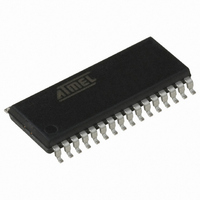AT90PWM3-16SQ Atmel, AT90PWM3-16SQ Datasheet - Page 212

AT90PWM3-16SQ
Manufacturer Part Number
AT90PWM3-16SQ
Description
IC AVR MCU FLASH 8K 32SOIC
Manufacturer
Atmel
Series
AVR® 90PWM Lightingr
Datasheet
1.AT90PWM3B-16SU.pdf
(361 pages)
Specifications of AT90PWM3-16SQ
Core Processor
AVR
Core Size
8-Bit
Speed
16MHz
Connectivity
SPI, UART/USART
Peripherals
Brown-out Detect/Reset, POR, PWM, WDT
Number Of I /o
27
Program Memory Size
8KB (8K x 8)
Program Memory Type
FLASH
Eeprom Size
512 x 8
Ram Size
512 x 8
Voltage - Supply (vcc/vdd)
2.7 V ~ 5.5 V
Data Converters
A/D 11x10b; D/A 1x10b
Oscillator Type
Internal
Operating Temperature
-40°C ~ 105°C
Package / Case
32-SOIC (7.5mm Width)
Processor Series
AT90PWMx
Core
AVR8
Data Bus Width
8 bit
Data Ram Size
512 B
Interface Type
SPI, USART
Maximum Clock Frequency
16 MHz
Number Of Programmable I/os
27
Number Of Timers
2
Operating Supply Voltage
2.7 V to 5.5 V
Maximum Operating Temperature
+ 105 C
Mounting Style
SMD/SMT
3rd Party Development Tools
EWAVR, EWAVR-BL
Development Tools By Supplier
ATAVRDRAGON, ATSTK500, ATSTK600, ATAVRISP2, ATAVRONEKIT, ATAVRFBKIT, ATAVRISP2
Minimum Operating Temperature
- 40 C
On-chip Adc
10 bit, 11 Channel
On-chip Dac
10 bit, 1 Channel
For Use With
ATSTK600-SOIC - STK600 SOCKET/ADAPTER FOR SOICATAVRMC200 - KIT EVAL FOR AT90PWM3 ASYNCATAVRFBKIT - KIT DEMO BALLAST FOR AT90PWM2ATSTK520 - ADAPTER KIT FOR 90PWM
Lead Free Status / RoHS Status
Lead free / RoHS Compliant
- Current page: 212 of 361
- Download datasheet (7Mb)
19.3.2
19.3.3
212
AT90PWM2/3/2B/3B
Parity Bit Calculation
Manchester encoding
The frame format used by the EUSART can be configured through the following
USART/EUSART registers:
•
•
USBS (UCSRC register of USART) and EUSBS (EUCSRB register of EUSART) select the num-
ber of stop bits to be processed respectively by the transmiter and the receiver. The receiver
stores the two stop bit values when configured in Manchester mode. When configured in level
encoded mode, the second stop bit is ignored (behavior similar as the USART).
The parity bit behavior is similar to the USART mode, except for the Manchester encoded mode,
where no parity bit can be inserted or detected (should be configured to none with the UPM1:0
bits. The parity bit is calculated by doing an exclusive-or of all the data bits. If odd parity is used,
the result of the exclusive or is inverted. The relation between the parity bit and data bits is as
follows:
If used, the parity bit is located between the last data bit and first stop bit of a serial frame.
Manchester encoding (also know as Biphase Code) is a synchronous clock encoding technique
used to encode the clock and data of a synchronous bit stream. In this technique, the actual
binary data to be transmitted are not sent as a sequence of logic 1's and 0's as in level encoded
way as in standard USART (known technically as Non Return to Zero (NRZ)). Instead, the bits
are translated into a slightly different format that has a number of advantages over using straight
binary encoding (i.e. NRZ).
Manchester encoding follows the rules:
•
•
Figure 19-2. Manchester Bi-phase levels
P
P
d
n
even
odd
UTxS3:0 and URxS3:0 (EUCSRA of EUSART register) select the number of data bits per
frame
UPM1:0 bits enable and set the type of parity bit (when configured in Manchester mode, the
parity should be fixed to none).
If the original data is a Logic 1, the Manchester code is: 0 to 1 (upward transition at bit
center)
If the original data is a Logic 0, the Manchester code is: 1 to 0 (downward transition at bit
center)
Parity bit using even parity
Parity bit using odd parity
Data bit n of the character
P
P
even
odd
Logical 0
=
=
d
d
n 1
n 1
–
–
⊕
⊕
…
…
⊕
⊕
d
d
3
3
⊕
⊕
d
d
2
2
Logical 1
⊕
⊕
d
d
1
1
⊕
⊕
d
d
0
0
⊕
⊕
0
1
4317J–AVR–08/10
Related parts for AT90PWM3-16SQ
Image
Part Number
Description
Manufacturer
Datasheet
Request
R

Part Number:
Description:
IC AVR MCU FLASH 8K 32QFN
Manufacturer:
Atmel
Datasheet:

Part Number:
Description:
MCU AVR 8K FLASH 16MHZ 32-QFN
Manufacturer:
Atmel
Datasheet:

Part Number:
Description:
DEV KIT FOR AVR/AVR32
Manufacturer:
Atmel
Datasheet:

Part Number:
Description:
INTERVAL AND WIPE/WASH WIPER CONTROL IC WITH DELAY
Manufacturer:
ATMEL Corporation
Datasheet:

Part Number:
Description:
Low-Voltage Voice-Switched IC for Hands-Free Operation
Manufacturer:
ATMEL Corporation
Datasheet:

Part Number:
Description:
MONOLITHIC INTEGRATED FEATUREPHONE CIRCUIT
Manufacturer:
ATMEL Corporation
Datasheet:

Part Number:
Description:
AM-FM Receiver IC U4255BM-M
Manufacturer:
ATMEL Corporation
Datasheet:

Part Number:
Description:
Monolithic Integrated Feature Phone Circuit
Manufacturer:
ATMEL Corporation
Datasheet:

Part Number:
Description:
Multistandard Video-IF and Quasi Parallel Sound Processing
Manufacturer:
ATMEL Corporation
Datasheet:

Part Number:
Description:
High-performance EE PLD
Manufacturer:
ATMEL Corporation
Datasheet:

Part Number:
Description:
8-bit Flash Microcontroller
Manufacturer:
ATMEL Corporation
Datasheet:

Part Number:
Description:
2-Wire Serial EEPROM
Manufacturer:
ATMEL Corporation
Datasheet:










